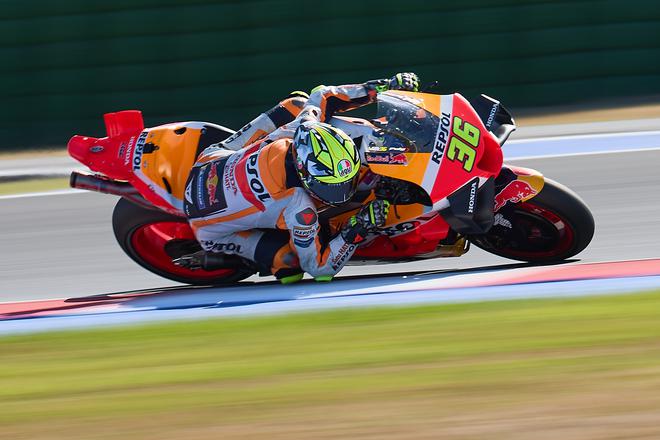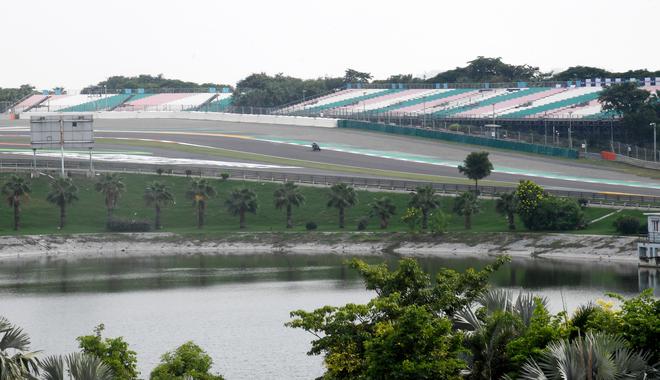

In 2011, India announced itself on the world motorsport stage when it hosted the Formula One Indian Grand Prix, the pinnacle of four-wheeler racing.
Ten years since the last F1 race in 2013, the Buddh International Circuit is set to host the premier championship for two-wheelers this weekend: the inaugural MotoGP Grand Prix of India.
The Hindu gives you the lowdown on everything you need to know about the sport and what to expect this weekend.
What is MotoGP?
Although the term ‘MotoGP’ is relatively new — it was coined only in 2002 — it refers more generally to the Grand Prix motorcycling championship. The history of the series goes back several decades. The first world championship was held in 1949, a year before the F1 championship started. Federation Internationale de Motocyclisme (FIM), the governing body for two-wheeler racing, sanctions the championship. Dorna Sports is the commercial rights holder.
In that first year, there were four classes of bikes, based on engine capacity: 125cc, 250cc, 350cc and 500cc. Since then, there have been 50cc and 80cc classes at the lower levels, while the 500cc was the premier class and the precursor to the current MotoGP. There was also a 750cc class in the 1970s for a brief while.
In 2002, the premier class became MotoGP, with 990cc four-stroke bikes. The machines became smaller between 2007 and 2011, down to 800cc, before changing to 1000cc in 2012, which continues to date.
Alongside MotoGP, every weekend also sees racing at the lower levels in Moto2 (765cc) and Moto3 categories (250cc), much like Formula 2 and Formula 3. This year, a new MotoE category for electric bikes, which had begun in 2019, got championship status.
Who makes the bikes? Can they be ridden on the streets?
MotoGP bikes are bespoke machines built for the explicit purpose of racing around a circuit and are not road-legal. The bikes are manufactured by some of the best known names in the automotive world, such as Honda, Yamaha, KTM, Ducati and Aprilia. Other big names in the sport’s past include Suzuki, Kawasaki and MV Agusta.
Which drivers and teams are on the grid this season?
The grid has 11 teams, each fielding two riders. The teams are either factory teams or satellite teams. Factory teams are owned and operated by the Original Equipment Manufacturers (OEM). On the current grid, Honda, Yamaha, Ducati, Aprilia and KTM are the five factory teams.
Some of the star names include Marc Marquez, the six-time champion who rides for Honda, reigning champion Francesco Bagnaia, who is with the Ducati factory team, and 2021 champion Fabio Quartararo, who is leading Yamaha’s charge.
Apart from the five factory-owned teams, there are satellite or independent teams which can buy a bike from one of the manufacturers and run it on their own, hiring mechanics and riders. Satellite teams can buy a factory team’s latest-spec bike or a year-old bike. For example, on the current grid, the Prima Pramac Racing team uses the latest bike from Ducati, while the Mooney VR46 Racing Team uses the 2022 Ducati bike.
How does the weekend unfold?
MotoGP follows a similar format to most motorsport series: practice sessions on Fridays, qualifying on Saturdays, and the race on Sundays. From 2023, MotoGP introduced Sprint Races at all weekends on Saturday, with the distance being 50% of the main race.
On Friday, there are two practice sessions, the first a 45-minute session called Free Practice-1 followed by a 60-minute session called Practice.
After a 30-minute Free Practice session on Saturday morning, qualifying will be held over two segments of 15 minutes each: Q1 and Q2. The qualifying results will set the grid for Saturday’s Sprint Race and Sunday’s main event.
The top ten riders from Friday’s Practice session get a direct entry into Q2, while the remaining riders will have to fight it out in Q1. The two fastest riders in Q1 will move into Q2, while the other riders will fill the grid slots from 13th, based on their fastest times.
The 12 riders in Q2 will then compete for pole position, and the results will determine who occupies the grid’s first four rows. MotoGP has three riders in staggered positions on each row. Sunday’s race spans 40-45 minutes, with a distance of 100-130 km depending on circuit length.
For example, there will be 24 laps of the 4.9-kilometre Buddh International Circuit.
Can an F1 circuit host bike races? Does the track need modifications?
Although the Buddh International Circuit was built mainly for F1, it was also envisioned as a track capable of hosting motorbike racing. In fact, in 2016, a round of the Asian Road Racing Championship was held at the venue.
However, the demands of MotoGP bikes are vastly different from those of ARRC or F1 cars, and some sections of the track had to be modified.
For the last few months, extensive resurfacing work has been undertaken to make it safe for both bikes and cars. More importantly, the asphalt run-off has been reduced and the gravel increased. Gravel traps reduce the bike’s speed if a rider goes off-track, making it safer.
Other features include Type A Air Fences, Type A Foam Safety Barriers and Type C Foam Barriers, imported from Austria and Italy, which will be installed at high impact zones (corners). Similarly, boundary fences at the last corner had to be pushed back to reduce the impact of potential crashes. The MotoGP layout will also have two fewer corners: turns six and seven have been made into a small straight, the riders will take the inner loop at the parabola section.
What logistical challenges did the Grand Prix of India face?
It is always a big challenge to hold a motorsport event in the country, considering it involves thousands of people and tonnes of cargo equipment getting in and out. MotoGP did not have a smooth start to the weekend, with many team personnel, riders and journalists not getting their visas on time, and some even missing their flights. Marquez — the biggest name in the sport currently — was one such rider forced to miss his flight on Tuesday as he had not received his visa in time. He reached the country only on Thursday.







